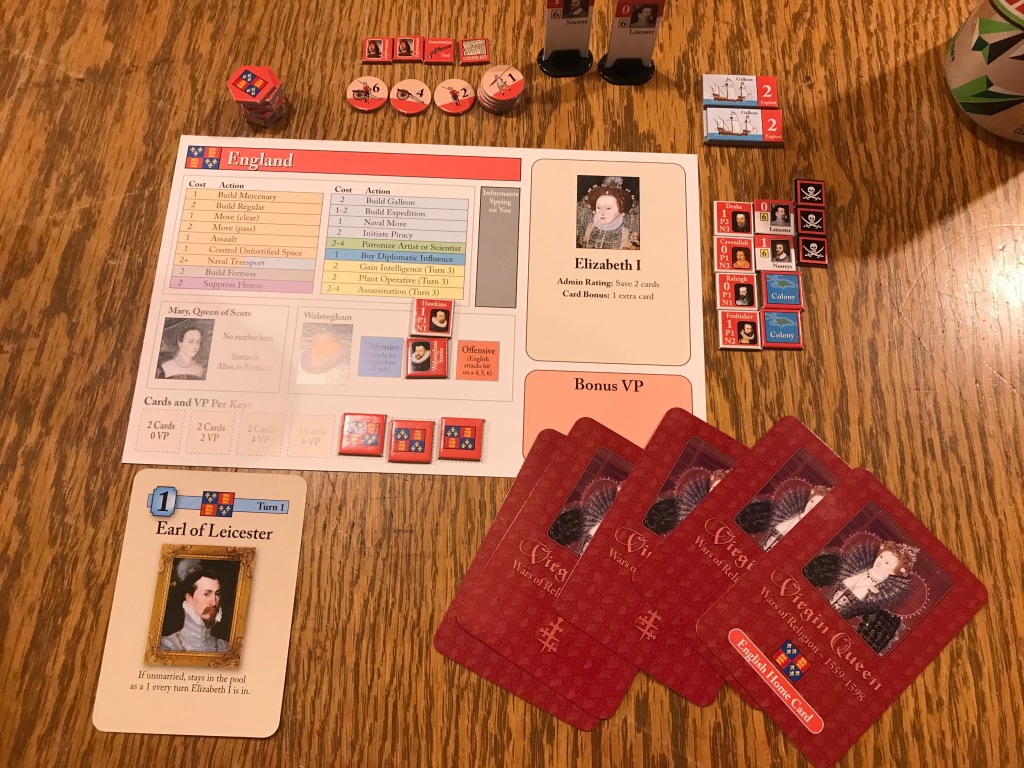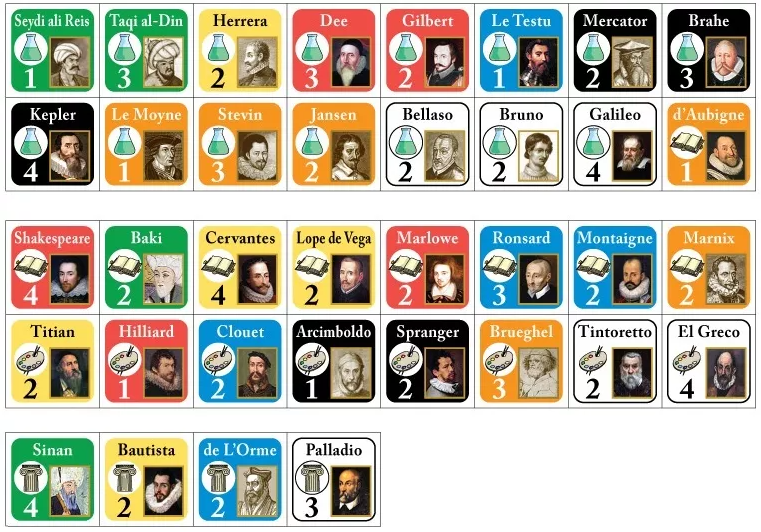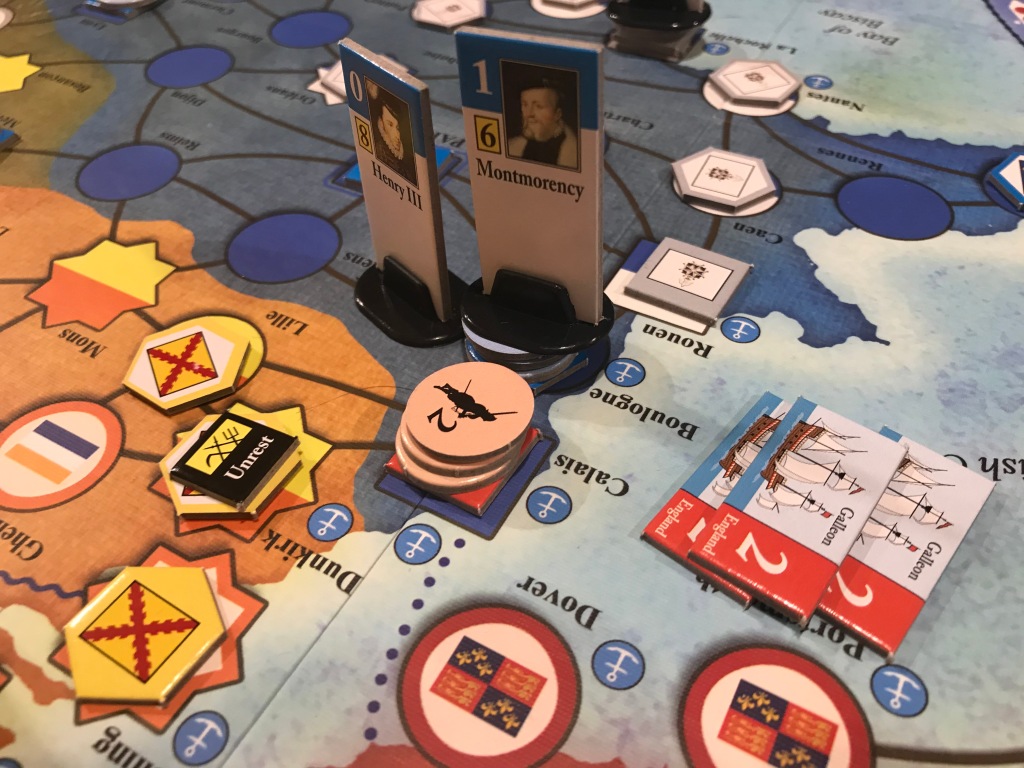We absolutely love to get together with people and play these really large and long wargames. Over the past few years, we have done this several times playing such games as Cataclysm: A Second World War, Genesis: Empires and Kingdoms of the Ancient Middle East, Here I Stand: Wars of the Reformation 1517-1555, Twilight Imperium, War Room and most recently Virgin Queen: Wars of Religion 1559-1598. There is really something to be said about a massive 6-player wargame being the penultimate achievement of wargaming. It is absolutely a thrilling experience to play these large games with maximum player count to understand and have the experience that the designers wanted us to have with it. It absolutely though doesn’t mean that these games cannot be played 2-player, as we have done with all of them due to necessity. They just seem to shine when there are 6 wargamers around the table struggling with the massiveness of the experience, and learning their own faction while trying desperately to accomplish things which will help them win the game.
Virgin Queen is a follow-up to Here I Stand and is a card driven wargame that looks at the Wars of Religion from after the Reformation to the end of the century and deals with the military, political and religious conflicts within Europe during the reigns of Elizabeth I of England and Philip II of Spain. As the game is card driven each of the various cards serves multiple purposes. Each card has a command point (CP) value in the top left corner which can be spent to take a variety of tasks available to your power, and an event which can be used in lieu of the CP. Cards labelled combat can be used in a fight, and cards labelled response can generally be used at any time with certain conditions that must exist in order to play. The other cool thing about each power is that they have what is referred to as 2 Home Cards and players will have to decide each turn which one they want to keep depending on their strategy for that round. This game is somewhat different than its predecessor in the series, but overall has the same method of how cards are used, generally the same type of victory conditions and the same mechanics in regard to movement, combat and siege. In fact, well over half of the rulebook is identical and really made picking this game up fairly easy as all were familiar with the concepts and mechanics. Where it feels different is that there is a larger focus on outside opportunities for VP, including arranged marriages between nations, the expansion of the New World exploration and colonization concept and the new ability for patronage of the Arts and Sciences for abilities and victory points. There is some sentiment out there that these additional opportunities create complexity and somewhat distract from the focus of the game. This was one thing that I wanted to test out as we played, and I came to a somewhat different conclusion which I will discuss later in this post.

Why Do We Play These Marathon Wargames
First off though, I want to share with you my thoughts on these type of large multi-player wargames. I have thought about this question many times. We all play games for various reasons. To win, for the rigor of competition, for strategy, to relive history and understand the whys, to socialize and interact with other players. But, I can provide a problem with each of those reasons. There are a lot of other things that we can do to experience these same things in a lot less time than 12-15 hours. So I have come to this final conclusion about why I choose to play these long, marathon wargames. The experience. The experience of sitting around a table for that long with friends. The experience of negotiating for your own good, while appearing to be helping out your opponents. The experience of strategizing how to go about doing what you know you need to do, but not necessarily understanding right away how. The experience of seeing through the designer’s eyes as you begin to learn the system and it’s intricacies. It is about the experience and how it makes us feel connected somehow to the historic timeline of events. And each other. And to the game.
I have played these games many times, and hope to play them many more, and come away each time having had the experience of my life. I think about the experience over and over….sometimes for weeks after! About decisions that I made and didn’t make. How one more card, or one more Op Point would have changed my fortunes. An unfortunate die roll and what would have happened had I just made that. Anything that can make you reflect that much on something is a good thing. I remember the first time we played Here I Stand with a large group. It lasted literally all day and ended very abruptly as the Ottomans came back and destroyed us all. The next day was Sunday and I was sitting in church and we began to sing A Mighty Fortress is Our God. That song transported me back to those moments in the game the day previous, where I as the Protestants felt that I was doing the work of God in bringing the truth to the people. That is why I play these games….to have that experience of reflection and contemplation. And that is the same way that I feel about Virgin Queen.

New Factions that Feel Familiar
Virgin Queen has some familiar factions from Here I Stand, including the Ottomans, English, French and Protestants, although the religious war and counter reformation process has been simplified. There are also new factions that somehow feel very familiar including the Spanish and the Holy Roman Empire. These new factions add some really interesting concepts to the mix and I was specifically interested in the Spanish. Spain is the 800 pound gorilla on the block and really has the ability to flex their muscles pretty early with their overseas New World outposts and their access to treasure and the benefits that this gives. Treasure tokens have benefits to the Spanish in the form of both possible Command Point and the ability to draw various Science bonuses. These range in value from 1-5CP, but there are other types of treasures that allow the player to draw a card, gain a VP, and gain a science bonus. Treasures simply allow the Spanish to extend their turn as once they’ve resolved an action card, they can use a treasure to increase those CP’s. But they are not allowed to do an action of the same color as one that has already been taken during this impulse. For example, if they have built a unit, the additional CP cannot used to take another build unit action. The Spanish will start with 4 treasures each turn and when the Spanish are the targets of Piracy, they can decide which of their treasures they surrender. One other interesting element, was that Spanish have somewhat of a dual role as they are really the defender of the Catholic faith and stand diametrically opposed to the Protestant player. The Spanish have to make sure the world stays as Catholic as possible because they actually gain Victory Points based on the progress of the Catholics in the religious war. This was a really interesting change as these additional VP were surprising to me and actually had me rooting for the Protestants as the English because it could be the source of a few VP for me. But, I didn’t want them to do too well and that is the balance.

The other new faction is the Holy Roman Empire. They are the faction that really can do a lot and doesn’t necessarily need to focus in on one thing. They have a very interesting mechanic where they will back a winner in the religious war at the beginning of the game and then can focus their actions on patronizing the arts and sciences and simply acting as a steady force in Europe to hold the aggressive powers at bay. They will be challenged by the Ottomans and they should spend some of their negotiating power on convincing them that they should attack Spain in the Mediterranean
The only faction that was included in Here I Stand that really felt a bit different was the Protestants. These are not your mother’s passive bible thumping missionaries but have swords, and armor and can bring some military might to the religious war. They can not only threaten their neighbors, but with their ability to foment rebellion in Holland and France, they can form pockets of military power to shore up their religious gains. I was actually shocked at the amount of fighting that they did and did very effectively. In fact, they were in the lead for most of the game and only lost out near the end.
Spies Amongst Us
While there are plenty of opportunities for directly attacking and hindering your enemies, Virgin Queen now adds some more clandestine methods to injure your opponents. A very interesting new element to the game is the addition of Espionage and Informants. This adds a nice additional wrinkle to the game and causes some real opportunities for the Spanish against the English. A power may spend 2 CP to add an operative to play and when an Informant is added, its counter is placed in the “Informants Spying on You” box on the power card of the intended target. It sits there, eyeing you and reminding you that you have a problem and must root out this evil influence in your court. When an Informant is spying, espionage activities that are used against the target power will receive additional dice. Spain may also use this action to add a Jesuit to the map if any remain on their Spanish Power Card. This Jesuit marker will be added to any space in England and will help to promote the Catholic cause. There is a special English Catholic Rebellion action that can be undertaken by Spain which is the Gunpowder Plot with Guy Fawkes. This can be devastating and end in an auto-game win if all goes well for the Spanish. Once per turn, Spain may spend from 3 to 5 CP on the English Catholic Rebellion action. Spending more CP allows the active player to roll more dice which ultimately increases the chances of success. The Spanish player rolls the number of attack dice indicated on the English Catholic Rebellion column of the Espionage table. But don’t worry, the English can defend themselves as they will get dice as well. The results from this can lead to an auto-win for Spain, to a number of Catholic Conversion attempts in England but also can backfire as the Spanish can lose a card for the next turn. This was a really interesting aspect that creates some late game tension and really changed the focus.
Assassination’s are also a viable tool in this world of back alley conversations. Each power may spend from 2 to 4 CP on
the Assassination action to try to remove a named army leader or Elizabeth I from play. Just as is the case in the Rebellion action, spending more CP allows the active player to roll more dice increasing their chances of success. The active player rolls the number of attack dice indicated on the Assassination column of the Espionage table and then calculate the dice rolled by the defending player in the same fashion. Each side rolls their dice and hits are scored on rolls of 5 and 6. The results are varied but the target can be killed and the assassinating power will earn 1 VP. We really felt that these added options made for a more interesting experience and allowed us to plot and scheme against each other. Remember that one of the greatest tricks of a CDG is forcing your opponent to spend their CP on actions that they don’t want to in place of doing things they should be doing.

Marriage is the Reason We are Gathered Here Today
As we all know, royal marriages have been used through the centuries and around the world as a political means to create alliances and to bring fractured or warring kingdoms together. In Virgin Queen, there are various opportunities to marry off lords and ladies for gain. All powers except the Ottoman have a pool of male and female royal princes and princesses for whom weddings can be arranged. Each Royal is represented by a two-sided card that provides information on that royals’ Marriage Bonus and should be used as an aide when arranging a marriage for that royal during the Negotiation Segment. This is where this gets interesting. These benefits listed on the card, sometimes only assist one power. We found that anything was up for bartering during this segment depending on how badly players wanted these marriages to go through. We saw mercenaries change hands, spaces be vacated, ships moved away from a threatening position, etc. This was the best part of this new mechanic and really made for a fun and engaging exercise. During the Marriage Resolution Phase, the royal couples that agreed to marry see how well their union has worked out.
The weddings are resolved in impulse order and 2d6 are rolled with the numeric values appearing in the upper left hand corner of each card added to this roll as a bonus. If the modified total is 12 or more, good things happen in the form of VP or next round bonus cards. But if things don’t go well, and the roll is low, there will be negative effects such as the loss of a card or even the death of the betrothed.

Elizabeth I is her own animal though for the English as she has her own Jilted by Elizabeth table. Each round that Elizabeth I remains unmarried, the English will gain +1 VP but as she ages from turn to turn, her numeric value will lessen by 1 and marrying her becomes less and less appalling to other suitors as the bonus will not necessarily guarantee a great result on the Marriage Resolution Table. That is the challenge with her as you have to balance that diminishing value with the ability to gain that +1 VP each turn and make the decision to finally marry her when it benefits you. I let her remain unmarried for four rounds until her bonus was only a 2 and the eventual union succeeded but not as well as excepted.
Lots of Options
Along with the royal weddings, Virgin Queen adds more options to allow players to gain VP’s in different ways…and frankly this was a really great part of the game! The players can now patronize Artists and Scientists from history to gain Victory Points. The players can spend 2-4CP to sponsor an Artist or a Scientist. 2CP gets them sponsored, 3CP confers a +1 DRM, and 4CP a +2 DRM. Artists and Scientists range in value from 1-4, and during the winter phase this process is resolved by rolling 2d6 and added the value of the Artist/Scientist and any bonuses from the spending of CP, and then you earn VP based on the result. You need at least a 10 to get anything. Artists confer 1-3VP, and scientists confer 1-2VP and possibly a special achievement. As an example, the player could gain the Observatory science achievement which will give a +2 DRM on all future science rolls. There are other beneficial achievements such as Cryptography (which grants a 1 extra die on Espionage attack or defense), Telescope (+1 to intercept or avoid battle die rolls) and Ravelin (+1 defense die in an Assault).

We enjoyed this element quite a lot. We have found with CDG’s where you spend your CP to take actions, sometimes you have 1 or 2 CP left in a round that you don’t know what to do with. This was a perfect way to simply throw these CP in and attempt to succeed in patronizing the arts and sciences. The dice rolls were also really amazing as we had several really, really bad rolls – snake eyes that came with the proclamation that the artist ran off with your money and gave you nothing in return – to box cars which resulted in great cheers of astonishment as the player gained 3 VP. This was a very good addition to the game and not one that caused any difficulty in rules or overhead.
Religious War is Streamlined
The struggle for the supremacy of religious dogma is present in this game as it was in Here I Stand as the Protestant, French and Spanish player will fight over which sect of Christianity will reign supreme. This religious battleground is limited to just the environs of Scotland, England, the Netherlands and France though and not most of Western Europe as before. The Spanish, English, Holy Roman Empire and Protestant players all earn VP based on the outcome of this struggle while the Spanish, French and Protestant players can win an Automatic Victory if the religious struggle swings too far in one direction.
The religious war aspects of Here I Stand were always more involved and required reference to a number of things, including the disposition of spaces near the target and other various modifiers. Also, the Papacy is now relegated to the role of a minor power, and Catholic Conversion attempts are specific to the Catholic countries. Protestant conversion attempts are still a major part of the Protestant player’s focus and the way they are carried out is much easier. A conversion attempt works by rolling a couple of d6’s, and if successful flipping over markers on the board. The roll will succeed to flip the location to the player’s side if the roll is higher than a 3 (4-6). If a 6 is rolled, which is considered a major success, this allows the player to flip a space that has various limiting factors present such as armies that are loyal to Catholicism, or Jesuits. If a 1 is rolled, the player has to add an unrest token to the space, which generates difficulties for the VP score. There are also actions that let the players preach sermons, if you’re Protestant or Spanish, and suppress heresy if you’re English, Spanish, or French. I didn’t play as the Protestants in Virgin Queen, but have several times in Here I Stand, and this process was just more fluid and frankly went much faster than previously when I felt like the Protestants turns would last for days sometimes. This was a very nice change to the playability of the game without sacrificing the intent of the mechanic nor taking away from the theme of the religious wars.

Within a Whisper of Winning….Several Times!
My final point with this game is that you are honestly never actually out of it as there are many ways to win the game, either through a VP victory or an automatic victory by meeting certain conditions. And if things have not gone your way in one area, such as with military conquest, you always have other ways to invest in VP. I actually nearly won about 5 times via an automatic victory by getting all of my keys captured but I always came up one short because I either didn’t have the CP to do anything more that turn, or one of my enemies saw what was happening and quickly mobilized to take away one of those keys. That is one of the really great aspects of both of the games in this series. I find them to be very balanced and each faction, while wildly asymmetric in their actions, goals and victory conditions, really is in it to win it from the beginning. You just have to understand your strategy, carry that strategy out and don’t get distracted by the bells and whistles, such as the arts and sciences. I know that statement kind of flies in the face of what I said earlier, but the main focus should always be what your faction does well, which doesn’t mean you cant dabble, but don’t dabble to the point of ignoring your bread and butter!
The ability to win at any moment really creates a lot of angst and tension, which I find to be a really interesting feeling during these games. In fact, in Virgin Queen, Spain is set up nicely to nearly win in the first few turns if players don’t get on them and take something away. This was a big point of discussion between the players as the game started and really got everyone in the mood of working together, while also trying desperately to carve out your own place in the world.
Virgin Queen is a very deep and rich experience of a wargame. There are a lot of moving parts and different bits and pieces to occupy your mind but they are all very well done and incorporate so much of the great history of this period into the game play. I felt like with this game that Ed Beach decided that the system shines with its interaction, such as negotiation, plotting and planning, and incorporated lots of new systems to enhance those elements such as assassinations, spies and even the incorporation of patronizing of the arts and sciences. There are obviously lots of strategies to explore here and the nuances of the different factions involved, and their array of powers and abilities, make for a very deep and engaging experience. In fact, this game is a lot like an onion and its many layers. You can play many times, and each time peel back new and unexplored elements until you find something that you like and that works for you and your strategy. This game is best when played with 6 players and groups will gain greater confidence and understanding about the game and its systems after many plays.
I know that you will ask the inevitable question about which of the two games you should get, either Here I Stand or Virgin Queen. My answer would be that Here I Stand is the perfect multi-player CDG and it is very hard to beat for me. But VQ really impressed me, and remember that this was just our first play, so I might feel a bit different after another play or two. But you cannot go wrong with either. They are both worthy of a spot on my shelf and I look forward to the third game in the series called Tanto Monta: The Rise of Ferdinand and Isabella, which is currently on the P500. If you are interested in what Tanto Monta has to offer, you can read our designer interview with Carlos Diaz Narvaez at the following link: https://theplayersaid.com/2021/04/12/interview-with-carlos-diaz-narvaez-designer-of-tanto-monta-the-rise-of-ferdinand-and-isabella-from-gmt-games/
Also, Virgin Queen is currently on the P500 as a reprint (2nd Printing) and it currently has 436 Orders to Date and you can reserve your copy for just $62.00 (regularly $92.00) on the GMT Games website at the following link: https://www.gmtgames.com/p-740-virgin-queen-2nd-printing.aspx
-Grant

VQ is just a great game. If this type of game is even remotely interesting to you, you owe it to yourself to get a few plays in.
LikeLiked by 1 person
Having bought Virgin Queen first, I instantly realized that I would introduce people to Here I Stand first when I picked it up; the rules just seem a lot easier to go over for a first-time play.
LikeLiked by 1 person
An enthusiastic and detailed write-up on VQ. Nicely done.
I was invited to play both HIS and VQ once at a couple GMT weekends several years ago; in both instances I was a total novice, and I basically was someone to fill a 6th seat. Despite feeling quite lost, over the course of the games I gained an appreciation for how much the regulars enjoy the experience and interaction this game brings.
I had an unopened VQ on the shelf for a few years, but I got into a phase where I sold off games that I thought I could never get enough of the right people into a group to play. I had a little bit of seller’s remorse afterward, and I ended up buying the updated version of HIS when it was released a few years ago. It’s still in the wrap on the shelf, not for lack of wanting to play, but more the challenge of getting a full table of friends together who would be willing to undertake the time investment to learn and hopefully enjoy it. That seems to me the biggest obstacle for these kinds of games. But…someday… 🙂
LikeLiked by 1 person
I agree and that is why these are perfect convention games. Tough to get the players together but worth every minute. Thanks for reading and commenting.
LikeLike
I love this game too. I am probably somewhat unique as I take on these types of game solitaire. No doubt a face-to-face would be awesome with a full complement of opponents!
LikeLiked by 1 person
Excellently written piece Grant, I feel you are really able to express yourself better on the blog pieces (no offence meant on how you come across on video).
I have played HIS and after reading of the nuances of this game, really want to try VQ. I also think you hit the nail on the head as to why we play these types of games.
LikeLiked by 1 person
Writing is much more effective as I can refer to the rules and pictures to coalesce my thoughts. Those videos are on the spot without much prep and are just intended to be impressions. Writing allows me to do more of a deep dive into rules and mechanics. That’s why I really prefer the blog. Just don’t have the time I once did.
LikeLike
That totally makes sense, thank you for the response.
Keep up the good work!
LikeLike